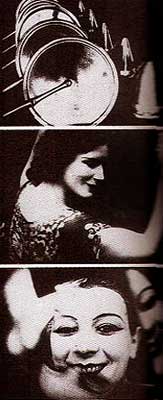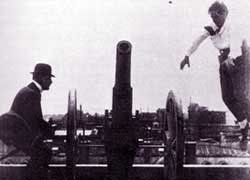 The first film by Rene Clair (1895-1981) was Entr'acte (1924). This silent film begins with stop-motion animation of a canon, momentarily joined by some slow-motion leaping of well-dressed men. So right away we know we're in the avant garde's Land of Odd rather than in a normative storytelling environment.
The first film by Rene Clair (1895-1981) was Entr'acte (1924). This silent film begins with stop-motion animation of a canon, momentarily joined by some slow-motion leaping of well-dressed men. So right away we know we're in the avant garde's Land of Odd rather than in a normative storytelling environment.
There follows twenty-two minutes of nutty cinematography depicting cityscapes upside down, dolls with inflating heads, chunky ballerina viewed from beneath her feet (panty fetish time), lights in & out of focus in darkness, hair caught on fire by animated match sticks, origami boat drifting in air, a strange carnival shooting gallery, with barely sufficient narrative content to keep it from seeming awfully long.
A large portion of all this nonsense is still pretty interesting, but a percentage of the first half relied on the fact that moving pictures were still pretty novel in the 1920s.
The second half takes on much more structure. Rene Clair's sense of humor shines through as in the revelation of the ballerina's identity, or most blackly, the happy urban rifleman with a pigeon landing on his hat, attracting the attention of another urban hunter. This is followed by the camel-drawn hearse followed by the original Ministry of Funny Walks.
By the time the hearse is in full runaway mode with the Funny Walks mourners flapping their arms & running & hopping at full tilt hoping to catch up, the comedy has become the dark belly of Keystone Cops slapstick.
The chase becomes increasingly surreal as motorers, cyclists, a legless man on a flat wheeled cart who eventually leaps up & has legs after all, an airplane, & a roller coaster join the chace, concluding in resurrection & magical vanishings.
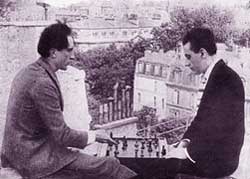 The musical score was added in 1967, when Rene Clair was still alive to oversee the score himself. So as intrusively latter-day musical additions go in silent film presentations, this one's as authentic as can be hoped for.
The musical score was added in 1967, when Rene Clair was still alive to oversee the score himself. So as intrusively latter-day musical additions go in silent film presentations, this one's as authentic as can be hoped for.
Generally categorized as a Dadaist film, this impression is enhanced by the cameo appearances of Marcel Duchamp & Man Ray. The black comedy may well be Dada in spirit though it is doubtful Clair thought to label it so. Once the shooting gallery urban hunter is introduced, the film takes as many pointers from Charlie Chaplin as it does from anything experimental.
It was not originally intended to be viewed with this score or even as a single film. It was initially shown in two parts as prelude & interlude for an "interventionist ballet" by Francis Picabia.
Considering that it was not meant as a stand-alone film, it works surprisingly well as we today experience it. Because of the story structure of the second half it does not test one's patience as can purely chaotic films of the avant garde.
It's a pretty great film really & kind of made me want to get some antique camera equipment & make a silent movie. Which is no doubt how Guy Maddin got started.
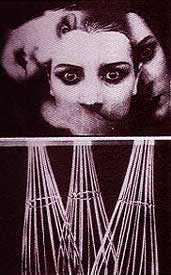 And while ballet is the subject, Ballet Mecanique (Charlot presente le ballet mecanique, 1924) is a purely Dada work of chaotic juxtopositions. And while ballet is the subject, Ballet Mecanique (Charlot presente le ballet mecanique, 1924) is a purely Dada work of chaotic juxtopositions.
It was photographed by Man Ray under Fernand Leger & Dudley Murphy's direction. We see Kiki of Montparnasse on a swing, then her hat is shown like a target, then her repulsive smile in extreme close-up, then a lot of shadows & shapes that defy cateogry or meaning.
It's a light show with little bits begging to be picked out & identified, mechanical devices in motion vying with the repetitive motions of human beings.
It is celebrating, if anything, motion itself, a mechanical ballet. Some critics have imposed on it a political intent, of machine vs. human. But it could just as well be interpretted as the machine world mirroring the actions of their human creators. Personally it strikes me as intentionally "just nonsense."
If it had been even a minute longer it'd be tiresome, but sixteen minutes is short enough to make it worthwhile even if for nothing else but the vagina-shaped horse collar's momentary dance, or the antic bodiless legs, or the cubist animation at the climax.
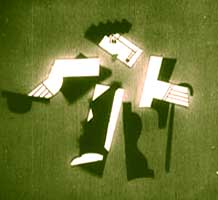 Regarded by some film historians as a precursor to MTV videos, Ballet Mecanique was presumedly intended not as a stand-alone film, but was meant to be viewed with a score by American composer George Antheil, & having indeed a visually symphonic feel. Regarded by some film historians as a precursor to MTV videos, Ballet Mecanique was presumedly intended not as a stand-alone film, but was meant to be viewed with a score by American composer George Antheil, & having indeed a visually symphonic feel.
Yet in reality the film debuted in 1924 without any score at all, & no one today is at all certain how Antheil's score could've fit, having been longer than the longest version of the film.
Antheil's separate Ballet Mecanique premiered in 1926 as a live performance of propellers & other moving mechanical devices, the main instrumentation being player pianos supported by drums & xylophone. So both the film & the composition were intended as to function separately as stand-alone works.
The film now has a forced version with Antheil's music for the first time fitted to the visuals. This premiered very late in the game, in 2000.
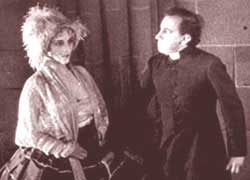 A film adaptation of a surrealist play by Antonin Artaud, Germaine Dulac's The Seashell & the Clergyman (La Coquille et le clergyman, 1927) is often cited as the first self-consciously surrealist film, though such high flights of absurdism were not actually new & avant gardists had been doing something or another of this type almost from the moment motion picture cameras were devised.
A film adaptation of a surrealist play by Antonin Artaud, Germaine Dulac's The Seashell & the Clergyman (La Coquille et le clergyman, 1927) is often cited as the first self-consciously surrealist film, though such high flights of absurdism were not actually new & avant gardists had been doing something or another of this type almost from the moment motion picture cameras were devised.
Famously at the film's premier, the play's author was in attendance, & shouted insults at Germaine Dulac (1882-1942), calling her a cow, believing she had ruined his play. However, I've often wondered if his antics weren't themselves a surrealist performance misunderstood by reporters since.
A rift certainly did develop between Dulac & Artaud, probably because as a writer of polemics her intellectualism was too challenging for her more egoistic compatriots. And in her own film theory she would ascribe authorship to the director not the scenarist because the visuals tell the story, not a script. Artaud as author might well take exception to this idea.
Also in 1927 British film censors banned it on the premise that if it had any meaning, that meaning was "doubtless objectionable."
Momentary exposure of breasts & the persistent portrait of the clergyman as some kind of monster would seem to be at the heart of censors' dislike of a novel & intriguing film.
Dulac did not like musical scores & the most authentic viewing will be without sound. She creates a richly textured visual experience & any sound is supposed to be restricted to each viewer's imagination.
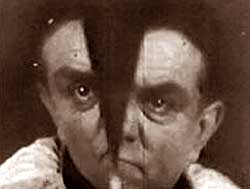 A clergyman with a key opens a door into dark hallways until he finds a door which he unlocks & enters dark hallways until he finds a door to unlock & enter, & so on until the viewers are groaning.
A clergyman with a key opens a door into dark hallways until he finds a door which he unlocks & enters dark hallways until he finds a door to unlock & enter, & so on until the viewers are groaning.
At last he encounters a soldier & a maiden who flee the checker-floored room into a park environment. Sundry other disconnected events occur with the pensive clergyman generally having the point of view. In his imagination he is strangling the maiden, & is clearly driven by bleak angst unsuited to his occupation. There's a bit of a Bella Lugosi aspect to
Weird visions haunt him as he sinks into inertia & despair. His visions include a journey by Chinese junk then tallship to an volcanic island fortress. In the fortress beautiful housemaids are dusting a huge scrying ball, in which the entranced clergyman's face appears.
From an achemist's broken beakers, clouds arise, & the soldier slips into the laboratory to take from the clergyman a shallow bowl of mercury. WIth this the soldier conducts a ritual either of evocation or exorcism, then dashes his sword about as the clergyman crawls across the floor.
For whomever realities' deconstruction appeals, the image of the clergyman crawling down the street after the dream-maiden is delightful stuff, & precisely a thing familiar from frustration-dreams. As chaotic as the film first seems, everything is occurring on a comprehensible plain of dream, nightmare, & emotion.
When the clergyman finds the maiden & soldier together, he takes on much more strongly the persona of a monster in a horror film. His violence & rage is impotent in the face of their connection to one another & exclusion of himself. His rival's head cracks &akmp splits open but repairs itself leaving the soldier unharmed.
At last he floats his rival like a small dirigible to a mountain top & tosses him into the volcano, & afterward continues to stalk the now lonely maiden. He rips her clothing off including her double-shell brasier, while all about, the world dances, all of which may be only an illusion captured in a shallow bowl of mercury.
Whatever meaning one finds in or imposes on this tale of jealousy & magic can only be speculative, like interpretting the dreams of others.
copyright © by Paghat the Ratgirl
|
